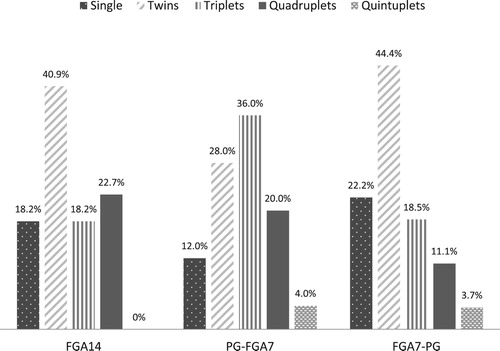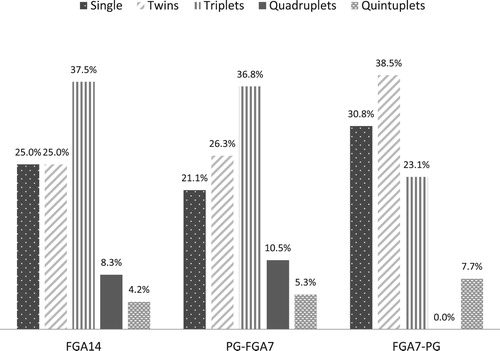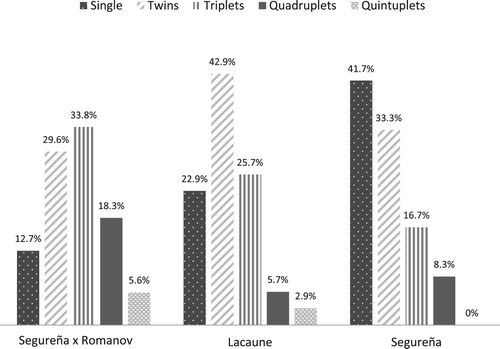ABSTRACT
The present study indicates that short-term progestagen-based protocols for synchronization of estrus and ovulation in sheep involving 7 days of progestagen insertion with administration of prostaglandin F2α at either insertion or removal of the progestagen sponge resulted in 80–90% fertility during the breeding season, while a classical long-term protocol of 14 days of progestagen insertion resulted in 77% fertility. During the non-breeding season, fertility was significantly higher for the 7-day protocol with prostaglandin administration at sponge insertion (79.2%) and for the 14-day protocol (80%) than for the 7-day protocol with prostaglandin administration at sponge removal (59.1%; P = 0.018). Prolificacy, in contrast, varied significantly with genotype, being higher in prolific breeds, but it did not vary with progestagen protocol or breeding season. These results suggest that short-term progestagen-based treatments can provide similar reproductive efficiency as long-term treatments, which may help practitioners reduce welfare and health issues while maintaining productivity.
1. Introduction
Sheep reproductive activity shows a seasonal pattern, with well-established breeding and non-breeding seasons. Seasonal anestrus usually begins in late spring and ends in mid-summer, though the extension and depth vary with age, breed and geographical location. After a transition period, the breeding season usually begins in late summer or early autumn in response to the shortening days, and it ends in early spring. Breeding seasonality likely reflects evolutionary pressure to ensure that lambing occurs during spring, when temperature and food availability are optimal. However, seasonal reproduction means seasonal availability of meat and milk. To ensure supply throughout the year, reproduction can be induced out-of-season. In addition, synchronization of reproductive activity can generate homogeneous lots of lambs with similar age and carcass size.
Induction and synchronization of estrus and ovulation usually involve the insertion of a progestagen-impregnated intravaginal sponge for 12–14 days, which is a protocol developed in the early 1960s (Robinson et al. Citation1967). When the sponge is removed, equine chorionic gonadotrophin (eCG) is injected intramuscularly (Abecia et al. Citation2012) to ensure induction of ovulation during the non-breeding season and to increase the rate of multiple births. Although commonly used, the use of progestagen for 12–14 days does not usually lead to the same fertility rate as after natural estrus (Killian et al. Citation1985; Scaramuzzi et al. Citation1988). One explanation of this lower fertility may be that too little progestagen is released from the sponge at the end of the insertion period, affecting ovulation quality (Menchaca and Rubianes Citation2004; Gonzalez-Bulnes et al. Citation2005). Moreover, such a long period of insertion can lead to vaginitis and sponge retention, which is contrary to the principles of animal welfare (Manes et al. Citation2015).
To shorten the insertion period, 6- to 7-day protocols were developed starting in the 1990s (Ungerfeld and Rubianes Citation1999; Viñoles et al. Citation1999; Knights et al. Citation2001), but this period is shorter than the half-life of a corpus luteum in the ovary. Hence corpus luteum lysis must be induced in cycling animals using a single dose of prostaglandin F2α or analog at sponge insertion (Letelier et al. Citation2009) or removal (Cox et al. Citation2012). Short-term protocols offer similar or better, but never lower fertility rates than long-term treatments (Menchaca et al. Citation2018). However, short-term treatments are less widely used than long-term treatments, primarily because most practitioners are unaware of them and because of uncertainty about whether the yields will justify the additional expense of prostaglandins and management.
The objective of the current trial was to compare 14- and 7-day progestagen treatments in fertility and prolificacy after natural breeding in reproductive and non-reproductive seasons. Prostaglandins were administered at sponge insertion or removal. Results were obtained for dairy and meat breeds reared under the same conditions in order to identify the influence of genetics on outcomes of the progestagen treatments.
2. Material and methods
The study was performed according to the Spanish Policy for Animal Protection RD53/2013, which complies with the European Union Directive 2010/63/UE about the protection of animals used for research. The study protocol was reviewed and approved by the Committee of Ethics in Animal Research of the Universidad CEU Cardenal Herrera (report CEEA17/019). Two consecutive trials were carried out on sheep aged 2–6 years old with mean body score of 3.5 ± 0.4 that were maintained outdoors with access to indoor facilities (Valencia, Spain; latitude 39°N), which allowed us to detect seasonality effects. A total of 99 sheep were analyzed during one breeding season (October-November) and 76 during one non-breeding season (May). Breed effects on fertility and prolificity were assessed by comparing results for 25 Lacaune dairy ewes, 25 Segureña meat ewes and 49 ewes from a commercial meat crossbreed (Segureña x Romanov) during the breeding season; and comparing results for 21 Lacaune, 14 Segureña and 41 crossbreed sheep during the non-breeding season.
Ovarian cyclic activity and ovulation were synchronized in all animals by intravaginal insertion of one progestagen-impregnated sponge (20 mg fluorogestone acetate, FGA; Chronogest®, MSD Animal Health, Madrid, Spain). At sponge removal, animals received one intramuscular injection of 400 IU of eCG (Foligon®, MSD Animal Health, Madrid, Spain). Sheep in each trial were divided into three equal groups, which were treated according to a classical 14-day protocol of progestative treatment (FGA14) or a 7-day protocol (FGA7). Insertion was performed 7 days later in the FGA7 groups so that the sponge was removed at the same time in all three groups. One FGA7 group received an intramuscular injection of 5 mg of prostaglandin F2α (Dinolytic®, Zoetis, Madrid, Spain) at sponge insertion (PG-FGA7) or sponge withdrawal (FGA7-PG). The prostaglandin treatment was designed to eliminate any active corpus luteum at sponge withdrawal.
Males were introduced in a ratio of 1:3 and allowed to remain with the sheep for 48 h in order to ensure that mating involved only sheep responding to the treatments. Fertility and prolificacy were assessed at pregnancy diagnosis on day 35 after male removal and at lambing. This assessment was carried out using transabdominal ultrasonography (NanoMaxx, Sonosite, Bothell, WA, USA).
2.1. Statistical analysis
Statistical analyses were performed using SPSS® 22.0 (IBM, New York, NY, USA). Heterogeneity in the results due to the potential confounding factors of breed, age, body condition and photoperiod was investigated in the model. Inter-group differences in numerical variables (body condition, age and prolificacy) were assessed for significance using analysis of variance (ANOVA) and the Greenhouse significance level, followed by Student-Newman-Keuls and Duncan post hoc tests. Inter-group differences in binomial variables (response to treatment and fertility) were assessed for significance using the chi-squared test. Binary logistic regression was used to assess the significance of treatment effects; this regression was performed in prospective steps based on Wald statistics with a significance criterion of P > 0.10. The regression model included first-degree interactions and potential confounding factors (age, body condition, breed and photoperiod). P < 0.05 was considered significant.
3. Results
3.1. Breeding season
Ultrasonography-based assessment of fertility, which was confirmed at lambing, indicated similar fertility rates during the breeding season for FGA7-PG (90%), PG-FGA7 (80%) and FGA14 (76.7%, P = 0.372). Similarly, prolificacy at lambing was similar among the three groups: FGA14, 2.5 ± 0.2; PG-FGA7, 2.8 ± 0.2; and FGA7-PG, 2.3 ± 0.2. The distribution of ewes giving birth to single or multiple calves is shown in . These results were confirmed using binary logistic regression to assess treatment effects. No effects due to possible confounding factors (age, body condition and breed) were found.
Figure 1. Percentages of ewes with single, double, triple, quadruple or quintuple births during the breeding season. FGA14, 14 days of progestative + eCG at withdrawal of the sponge; PG-FGA7, 7 days of progestative + PGF2α at sponge insertion + eCG at sponge withdrawal; FGA7-PG, 7 days of progestative + PGF2α and eCG at sponge withdrawal.

3.2. Non-breeding season
Fertility during the non-breeding season was similar for PG-FGA7 (79.2%) and FGA14 (80%), and significantly lower for FGA7-PG (59.1%; P = 0.018). The distribution of ewes with single and multiple births () was similar to that during the breeding season, with a mean litter size of 2.4 ± 0.2 for FGA14, 2.5 ± 0.3 for PG-FGA7 and 2.2 ± 0.3 for FGA7-PG. These results were confirmed by binary logistic regression, which detected no significant effects due to potential confounding factors (age, body condition or breed).
Figure 2. Percentages of ewes with single, double, triple, quadruple or quintuple births during the non-breeding season. FGA14, 14 days of progestative + eCG at withdrawal of the sponge; PG-FGA7, 7 days of progestative + PGF2α at sponge insertion + eCG at sponge withdrawal; FGA7-PG, 7 days of progestative + PGF2α and eCG at sponge withdrawal.

3.3. Breed-related effects
No significant breed-related effects on fertility were observed for any of the treatments during breeding or non-breeding seasons. Overall fertility reached 78.3% for Lacaune, 76.7% for Segureña and 78.9 for Segureña x Romanov sheep. Nevertheless, breed did affect prolificacy and distribution of single and multiple births (): Segureña ewes showed a significantly higher percentage of single births (41.7%) than Lacaune (22.9%) and Segureña x Romanov ewes (12.7%; P = 0.05).
4. Discussion
The present study indicates that a 7-day progestagen-based protocol for synchronization of estrus and ovulation led to similar fertility and prolificacy after natural breeding than classical 14-day protocols. However, our results also evidence the existence of a seasonality-related effect on fertility yields which may influence the election of the timing of PGF2α injection in the short-term protocols (either at insertion or removal of the progestagen-impregnated sponge; PG-FGA7 and FGA7-PG, respectively). On the other hand, prolificacy was modulated only by genotype, being higher in prolific breeds; genotype did not significantly interact with progestagen protocol or breeding season.
Our results suggest that, during the breeding season, both PG-FGA7 and FGA7-PG can be as effective as a classical long-term treatment. We hypothesize that the 13% higher fertility in the FGA7-PG group reflects the presence of early-stage corpora lutea in a certain proportion of animals in the PG-FGA7 group, such as females on days 1 or 2 after ovulation, which corresponds to approximately 12% of the mean length of the estrous cycle. Prostaglandin is effective only starting on day 3 after ovulation (Rubianes and Menchaca Citation2003; Contreras-Solis et al. Citation2009a). Contrary to what was observed during the breeding season, the PG-FGA7 group showed higher fertility than the FGA7-PG group during the non-breeding season, when most animals are expected to lack corpora lutea. This seasonality is surprising: we did not expect PGF2α injection to significantly affect fertility because of the absence of corpora lutea in the anestrous season.
Future studies should examine why administering PGF2α immediately prior to the follicular phase is deleterious specifically during the non-breeding season. The decrease in fertility should be related either to deficiencies in the quality of the preovulatory follicles and their oocytes, in the functionality of corpora lutea and/or in the processes of embryo implantation and early development. Prostaglandins have been associated with disruptions of ovulatory follicular dynamics, normal luteal development and luteolysis, which can affect the time from treatment to ovulation (Barret et al. Citation2002). PGF2α injection has also been associated with reduced or delayed endometrial sensitivity to IFN-τ (Ruiz-González et al. Citation2012), which is critical for conceptus implantation and further growth and development in ruminants (Spencer and Bazer Citation2004; Gray et al. Citation2006). None of these associations appears to explain the observed seasonality of PGF2α effects. We hypothesize that the lower efficiency of reproductive processes during the non-breeding season means that any disturbance will show a greater effect during that period than during the breeding season.
Short progestagen protocols are associated with lower risk of vaginitis arising because of prolonged presence of the sponge within the vagina (Manes et al. Citation2015). This, combined with our observation that short protocols can be as effective as longer ones, means that short treatments may be a faster, more cost-effective, and more humane procedure for synchronization and ovulation. While the shorter protocols carry the added cost of PGF2α, this cost can be reduced by using lower doses. Reduced doses appear to be equally effective as higher doses for inducing luteolysis, synchronizing estrus and ovulation as well as yielding adequate corpora lutea (Contreras-Solis et al. Citation2009b).
Although further studies are needed, the current results suggest the potential effectiveness of short-term protocols for fixed-time artificial insemination. Males in our study were allowed to mate with sheep for only 48 h after progestagen withdrawal. Hence, the high fertility observed here must reflect high prevalence of estrus onset and mating acceptance. The results described here argue that short-term progestagen-based treatments can be as effective as long-term treatments while reducing welfare and health issues.
Acknowledgments
Authors thank CEU-Cardenal Herrera farm staff for assistance with animal care and handling.
Disclosure statement
No potential conflict of interest was reported by the authors.
References
- Abecia JA , Forcada F , Gonzalez-Bulnes A. 2012. Hormonal control of reproduction in small ruminants. Anim Reprod Sci. 130:173–179. doi: 10.1016/j.anireprosci.2012.01.011
- Barret DW , Bartlewski PM , Cook SJ , Rawlings NC. 2002. Ultrasound and endocrine evaluation of the ovarian response to PGF2α given at different stages of the luteal phase in ewes. Theriogenology. 58:1409–1424. doi: 10.1016/S0093-691X(02)01038-5
- Contreras-Solis I , Vasquez B , Diaz T , Letelier C , Lopez-Sebastian A , Gonzalez-Bulnes A. 2009a. Efficiency of estrous synchronization in tropical sheep by combining short-interval cloprostenol-based protocols and “male effect”. Theriogenology. 71:1018–1025. doi: 10.1016/j.theriogenology.2008.11.004
- Contreras-Solis I , Vasquez B , Diaz T , Letelier C , Lopez-Sebastian A , Gonzalez-Bulnes A. 2009b. Ovarian and endocrine responses in tropical sheep treated with reduced doses of cloprostenol. Anim Reprod Sci. 114:384–392. doi: 10.1016/j.anireprosci.2008.10.013
- Cox JF , Allende R , Lara E , Leiva A , Díaz T , Dorado J , Saravia F. 2012. Follicular dynamics, interval to ovulation and fertility after AI in short-term progesterone and PGF2α oestrous synchronization protocol in sheep. Reprod Domest Anim. 47:946–951. doi: 10.1111/j.1439-0531.2012.01996.x
- Gonzalez-Bulnes A , Veiga-Lopez A , Garcia P , Garcia-Garcia RM , Ariznavarreta C , Sanchez MA , Tresguerres JA , Cocero MJ , Flores JM. 2005. Effects of progestagens and prostaglandin analogues on ovarian function and embryo viability in sheep. Theriogenology. 63:2523–2534. doi: 10.1016/j.theriogenology.2004.10.013
- Gray CA , Abbey CA , Beremand PD , Choi Y , Farmer JL , Adelson DL , Thomas TL , Bazer FW , Spencer TE. 2006. Identification of endometrial genes regulated by early pregnancy progesterone and interferon tau in the ovine uterus. Biol Reprod. 74:383–394. doi: 10.1095/biolreprod.105.046656
- Killian DB , Kiesling DO , Warren JR. 1985. Lifespan of corpora lutea induced in estrous-synchronized cycling and anoestrous ewes. J Anim Sci. 61:210–215. doi: 10.2527/jas1985.611210x
- Knights M , Maze TD , Bridges PJ , Lewis PE , Inskeep EK. 2001. Short-term treatment with a controlled internal drug releasing (CIDR) device and FSH to induce fertile estrus and increase prolificacy in anestrous ewes. Theriogenology. 55:1181–1191. doi: 10.1016/S0093-691X(01)00476-9
- Letelier CA , Contreras-Solis I , García-Fernández RA , Ariznavarreta C , Tresguerres JA , Flores JM , Gonzalez-Bulnes A. 2009. Ovarian follicular dynamics and plasma steroid concentrations are not significantly different in ewes given intravaginal sponges containing either 20 or 40 mg of fluorogestone acetate. Theriogenology. 71:676–682. doi: 10.1016/j.theriogenology.2008.09.030
- Manes J , Campero C , Hozbor F , Alberio R , Ungerfeld R. 2015. Vaginal histological changes after using intravaginal sponges for oestrous synchronization in anoestrous ewes. Reprod Domest Anim. 50:270–274. doi: 10.1111/rda.12482
- Menchaca A , dos Santos-Neto PC , Cuadro F , Souza-Neves M , Crispo M. 2018. From reproductive technologies to genome editing in small ruminants: an embryo’s journey. Anim Reprod. 15:984–995. doi: 10.21451/1984-3143-AR2018-0022
- Menchaca A , Rubianes E. 2004. New treatments associated with timed artificial insemination in small ruminants. Reprod Fert Dev. 16:403–414. doi: 10.1071/RD04037
- Robinson TJ , Moore NW , Holst PJ , Smith JF. 1967. The evaluation of several progestogens administered in intravaginal sponges for the synchronization of estrus in the entire cyclic Merino ewe. In: Robinson TJ , editor. Control of the ovarian cycle in the sheep. Sydney, Australia : White and Bull PTY Ltd; p. 76–91.
- Rubianes E , Menchaca A. 2003. The pattern and manipulation of ovarian follicular growth in goats. Anim Reprod Sci. 78:271–287. doi: 10.1016/S0378-4320(03)00095-2
- Ruiz-González I , Sanchez MA , García-Palencia P , Sánchez B , García-Fernández RA , González-Bulnes A , Flores JM. 2012. Differences in uterine immunoexpression of PR, ER and OTR when comparing prostaglandin- to progestagen-based protocols for ovine estrus synchronization. Anim Reprod Sci. 133:93–100. doi: 10.1016/j.anireprosci.2012.06.015
- Scaramuzzi RJ , Downing JA , Campbell BK , Cognie Y. 1988. Control of fertility and fecundity of sheep by means of hormonal manipulation. Aust J Biol Sci. 41:37–45. doi: 10.1071/BI9880037
- Spencer TE , Bazer FW. 2004. Conceptus signals for establishment and maintenance of pregnancy review. Reprod Biol Endocrinol. 2:49. doi: 10.1186/1477-7827-2-49
- Ungerfeld R , Rubianes E. 1999. Effectiveness of short-term progestogen primings for the induction of fertile oestrus with eCG in ewes during late seasonal anoestrus. Anim Sci. 68:349–353. doi: 10.1017/S1357729800050347
- Viñoles C , Meikle A , Forsberg M , Rubianes E. 1999. The effect of subluteal levels of exogenous progesterone on follicular dynamics and endocrine patterns during the early luteal phase of the ewe. Theriogenology. 51:1351–1361. doi: 10.1016/S0093-691X(99)00079-5

